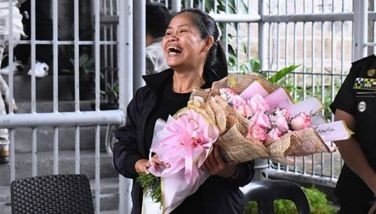PCIJ: Mangudadatu’s wealth up by 79% from 2010 to 2011
MANILA, Philippines - Maguindanao may be one of the poorest provinces in the country, but the Philippine Center for Investigative Journalism (PCIJ) revealed yesterday that Gov. Esmael Mangudadatu is a millionaire “many times over.â€
In the latest batch of articles released as part of its series on political clans in the Autonomous Region in Muslim Mindanao (ARMM), the PCIJ said the re-electionist Maguindanao governor’s wealth increased by at least 79 percent or more than P173 million in 2011 from his declared wealth in 2010 when he was first elected to the post.
The PCIJ said Mangudadatu’s statement of assets, liabilities and net worth (SALN) showed that the governor declared P390.6 million in 2011, which was 79.8 percent higher than the P217-million net worth he declared in 2010.
Mangudadatu was worth over P182 million in 2009, the year when the infamous Maguindanao massacre happened.
The massacre on Nov. 23, 2009 resulted in the death of 58 people, including the wife of then Vice Mayor Mangudadatu of Buluan and two of his sisters, two female lawyers and 30 journalists who covered the supposed filing of certificate of candidacy of Mangudadatu who would run for governor and challenge a scion of the Ampatuan clan.
The Mangudadatus have blamed the Ampatuans for the killings, specifically pointing to former mayor Andal Ampatuan Jr. of Datu Unsay town as the leader of more than 100 armed men who waylaid Mangudadatu’s supporters.
The Ampatuans denied any involvement in the massacre.
Judge Jocelyn Solis-Reyes of the Quezon City Regional Trial Court is handling the multiple murder charges filed against 197 suspects, including members of the Ampatuan clan, who are all detained at Camp Bagong Diwa in Bicutan, Taguig.
The PCIJ was able to obtain copies of 2011 SALNs of 54 out of 81 governors in the country.
The report noted that of the 54 governors, Mangudadatu ranked second in terms of wealth, next to Batangas Gov. Vilma Santos who has a joint net worth with her husband Sen. Ralph Recto of P426 million in 2011.
According to the PCIJ, the bulk of Mangudadatu’s wealth increase in 2011 was due to the increase in value of his previously declared assets.
His real property assets increased from P170 million to P293 million, while his personal assets grew from P62 million in 2010 to P96 million in 2011.
Mangudadatu did not have any liability in 2011, meaning he settled the P15-million liability declared in his 2010 SALN.
The report quoted Mangudadatu as saying that his previously acquired assets grew in value in 2011 because “aside from the development and also the improvement introduced to the assets, the assessed values of mostly real properties in Maguindanao dramatically increased more than two-fold.â€
“I honestly believe that I properly prepared and filed (my SALN) in accordance with pertinent laws and practice,†the governor was quoted as saying.
PCIJ noted that the governor reported a P15-million increase in his cash on hand and in bank in his 2011 SALN, as well as included newly acquired properties such as a commercial lot in Davao del Sur worth P1.1 million.
“The governor’s SALN does not provide sufficient information about how he was able to acquire millions worth of more properties in 2011,†said the report, noting that Mangudadatu did not delist any property except for a “Laboratory Building†worth P1.5 million.
Mangudadatu reportedly said that he used his income from “different ventures†to acquire more properties in 2011 through “installments and payments from those who owed me money and (had used) their property as collateral.â€
PCIJ said that while the governor did not declare any entity in the business interests and financial connections section of his SALNs, he listed an ice plant, a gasoline station, a beauty parlor, and a resort as part of his assets.
Pols used dynasties to win polls
In the three-part report, PCIJ multimedia director Ed Lingao said the erosion of governance in Maguindanao – a province where political clans have dominated for decades – was because the national government allowed “clan politics and clan dynamics†to become a part of the “relationship between the local families and the national government leadership.â€
He cited the 2004 and 2007 elections, when the administration slate of then President Gloria Macapagal-Arroyo secured a wide margin of votes in Maguindanao that was then ruled by the Ampatuan political clan.
“In return, the Arroyo administration endorsed the rule of the clan whenever its interests intersected with that of the government in power,†read the article.
Lingao said governance institutions ensure “empowered constituencies, enriched debate, and leveled the playing field for new ideas and new personalities.â€
It was reported that more than 400 candidates running for elective posts in Maguindanao in the May 13, 2013 polls are carrying surnames or middle names of one of at least 23 dominant political clans in Maguindanao.
The PCIJ noted that the Ampatuan clan, while failing to field candidates in the province’s top two posts, still dominate the ballot lists with 80 candidates running for various elective positions.
Among them were the wives of detained clan members Zaldy, Andal Jr. and Andal Sr., all suspects in the massacre.
Poor governance
Despite the amount of money pouring into the province, PCIJ noted Maguindanao’s poor rating in the Good Governance Index of the National Statistical Coordination Board (NSCB) in 2005 and 2008.
The PCIJ reported that the incidence of poverty in the province is recorded at over 40 percent, almost double the nationwide poverty incidence of around 25 percent.
The report likewise noted the short lifespan of residents in the province, according to the provincial human development index of the NSCB. Maguindanaoans have a life expectancy of 58.5 years, the third lowest after Sulu and Tawi-Tawi.
PCIJ also said that only 38 personnel health workers are serving every 1,000 residents in 2008. Only two banks are operating in the province as of 2009.
- Latest
- Trending





























